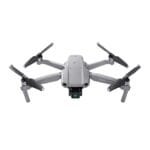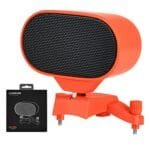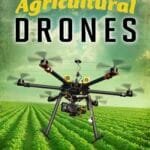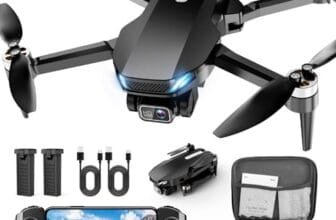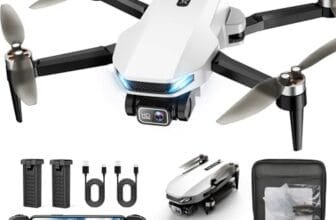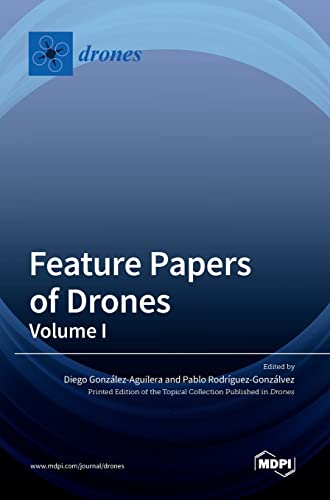
Drones play a vital role in coral reef monitoring. They offer unparalleled access to underwater ecosystems, helping researchers gather crucial data.
Coral reefs are vital for marine life, supporting diverse species. Monitoring these ecosystems is crucial for their preservation. Drones have emerged as an effective tool for this purpose. They can capture detailed images and videos of coral reefs, providing researchers with valuable insights.
With advanced technology, drones can explore hard-to-reach areas without disturbing marine life. This blog post explores the best drones for coral reef monitoring, focusing on their features and benefits. It will guide you in selecting the right equipment for efficient underwater exploration. Stay with us to discover how drones contribute to preserving our precious coral reefs.
Feature Papers Of Drones: Volume I

The ideal customer for the “Feature Papers of Drones: Volume I” is anyone involved in or fascinated by the field of drone technology. This includes academics, researchers, industry professionals, and enthusiasts who are eager to stay updated with the latest developments in drone technology and research. If you are someone who loves to delve deep into innovative technologies or are part of a team working on cutting-edge drone applications, this volume is a must-have for your collection.
Pros:
- Comprehensive Content: Covers a wide range of topics related to drones, providing valuable insights.
- High-Quality Publication: Published by Mdpi AG, known for its quality academic resources.
- Extensive Volume: Contains 458 pages of in-depth research and analysis.
- Recent Publication: Offers the most up-to-date information as of 2023.
Cons:
- Weight: At 2.599 pounds, it might be cumbersome for on-the-go reading.
- Technical Jargon: May contain complex terminology that could be challenging for beginners.
The “Feature Papers of Drones: Volume I” boasts a collection of insightful papers that explore the latest trends and innovations in drone technology. With its comprehensive coverage, readers can expect to gain a broad understanding of various applications, challenges, and future prospects within this rapidly evolving field. The volume is meticulously curated to offer high-quality research that is both informative and thought-provoking, making it an essential resource for those seeking to broaden their knowledge and stay ahead of the curve in drone technology.
Each paper within this volume is crafted to deliver practical insights and scientific analyses that can be directly applied to real-world scenarios. Whether you are developing new drone applications, conducting academic research, or simply have a keen interest in the technological advancements of drones, this volume serves as a valuable reference. The book’s detailed discussions and case studies provide readers with a clear understanding of the potential and limitations of drones, enabling informed decision-making and innovative problem-solving.
To buy this product, click here.
Feature Papers Of Drones: Volume Ii

Feature Papers of Drones: Volume II is an ideal purchase for researchers, academics, and professionals in the field of drone technology and aerial robotics. This comprehensive volume provides in-depth insights and advancements in drone applications, making it a valuable resource for anyone looking to stay abreast of the latest developments in this rapidly evolving industry.
Pros:
- Comprehensive coverage of drone technology.
- Authored by reputable industry experts.
- Contains 662 pages of detailed research and analysis.
- Published by Mdpi AG, ensuring high-quality content.
Cons:
- The weight of the book may be cumbersome for some users.
- Price may be higher compared to shorter publications.
The Feature Papers of Drones: Volume II offers an expansive look at the latest advancements in drone technology. With a total of 662 pages, readers are introduced to cutting-edge research and case studies that explore various applications of drones in industries such as agriculture, surveillance, and environmental monitoring. This book serves as a critical resource for those looking to understand the complexities and potential of drone technology.
One of the standout features of this volume is its thorough analysis of drone capabilities and limitations. The research presented in these papers allows users to make informed decisions when implementing drone technology in their projects. By understanding both the pros and cons of drone use, professionals can better tailor their strategies to suit their specific needs, ultimately leading to more efficient and effective outcomes.
To buy this product, click here.
Frequently Asked Questions
What Are The Best Drones For Coral Reef Monitoring?
The best drones for coral reef monitoring offer high-resolution cameras and long battery life. They need robust GPS for precise navigation. Consider drones with underwater capabilities or those that can withstand marine conditions. Popular choices often include DJI models and specialized drones featured in the “Feature Papers of Drones” series.
Why Use Drones For Coral Reef Monitoring?
Drones provide a non-invasive way to monitor coral reefs. They offer aerial views, capturing large areas quickly. This helps in assessing reef health and identifying threats. Using drones saves time and resources compared to traditional monitoring methods. They also allow researchers to access remote or difficult-to-reach areas.
How Do Drones Help In Coral Reef Conservation?
Drones help identify areas of coral bleaching and damage. They collect data to support conservation efforts. By monitoring changes over time, drones help in understanding the impact of climate change. They also assist in creating more effective conservation strategies, ensuring the protection and recovery of coral ecosystems.
What Features Are Essential In Drones For Reef Monitoring?
Essential features include high-resolution cameras, GPS, and long flight times. Waterproof designs or those with splash resistance are beneficial. Stability in windy conditions is important for clear imagery. Some drones also offer automated flight paths, which are useful for consistent monitoring over time.
Are Drones Better Than Traditional Methods For Monitoring Reefs?
Drones offer a unique advantage over traditional methods. They are faster and cover larger areas efficiently. Drones reduce the need for divers, minimizing human impact on reefs. They provide real-time data and high-quality images. However, they should complement, not completely replace, traditional monitoring techniques.
Conclusion
Exploring drones for coral reef monitoring offers promising advancements. These tools help researchers gather vital data efficiently. They offer a bird’s-eye view of underwater ecosystems. Drones in feature papers of drones: volume i and ii showcase diverse capabilities. They provide high-resolution imagery.
They ensure precise mapping of coral structures. The ease of operation makes them accessible for many users. Researchers can track changes over time. This aids in understanding environmental impacts on reefs. Drones also minimize human disturbance. This supports ethical research practices.
Choosing the right drone depends on specific needs. Consider range, camera quality, and battery life. Each drone brings unique advantages. They are powerful allies in conservation efforts. As technology evolves, their role becomes more significant. Drones contribute to preserving coral reefs for future generations.
Embrace these tools to enhance your research capabilities. Protecting coral reefs is crucial. Together, we can make a difference.

